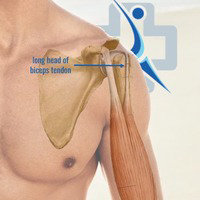Biceps Tendon Subluxation

What is the long head of biceps tendon?
The biceps muscle travels from just above the shoulder joint to just below the elbow joint. Its upper attachment divides into two tendons: the ‘long head’ and the ‘short head’. The long head of biceps tendon travels deep into the shoulder joint and actually merges with the lining of the joint. The tendon sits in a deep groove in the arm bone called the ‘bicipetal groove’ and it is held in place in that groove by a ligament called the transverse humeral ligament.
What is biceps tendon subluxation?
Sometimes the biceps tendon can pop out of its groove. This usually happens because of a tear of the overlying ligament. In other cases, some people are just born with a particularly shallow bicipital groove which puts the tendon at risk of popping out under load.
Why does biceps tendon subluxation cause pain?
The biceps tendon has a lining called a tendon sheath. If the biceps tendon pops in and out of its groove, it can cause trauma and therefore inflammation to the tendon sheath. It is usually the tendon sheath inflammation that causes the pain but the subluxation if the tendon that causes the inflammation in the first place.
What are the symptoms of biceps tendon subluxation?
The symptoms felt with this condition can be quite variable. Some people actually describe feeling a ‘flicking’ sensation that feels like a rope, string or band flicking back and forward across the front of the shoulder. Others just get a vague deep anterior shoulder pain in certain positions and under certain loads. In other cases, it can be quite a sharp pain.
How is long head of biceps tendon subluxation diagnosed?
An expert Sport and Exercise physician can often make the diagnosis based on the history and examination findings but confirmation can easily be made by ultrasound if necessary.
What is the treatment for biceps tendon subluxation?
Usually the first line of treatment it to injection the lining of the tendon with a cortisone and a local anaesthetic. Neither of these two things will make the biceps tendon instantly stable again but it will help in two ways. Firstly, if the anaesthetic instantly relieves symptoms, then the diagnosis is confirmed without the need for further investigations. Secondly, the pain usually only occurs due to excessive inflammation of the tendon sheath. By resolving the inflammation, the tendon might remain unstable but not painfully so and may not require any further treatment. Recurrent pain with recurrent instability may require key-hole surgery which is a last resort but normally has excellent success rates.





















